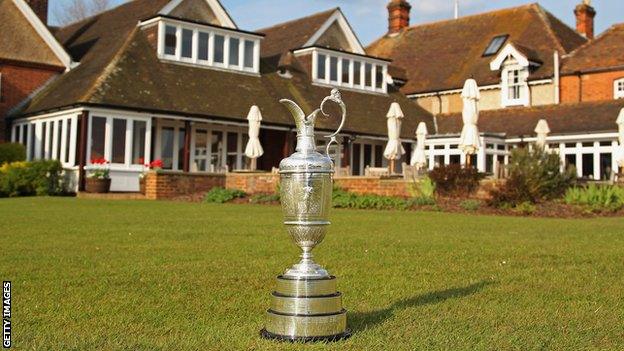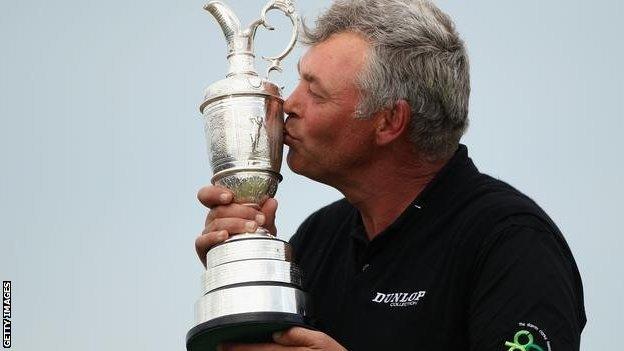The Open 2020: Why qualifying pros outweigh the cons
- Published
- comments

Royal St George's hosted the first Open Championship to be played outside of Scotland in 1894
As Royal St George's glistens with a coating from the first winter frosts, it feels a world away from the anticipated warmth of July sunshine and the heat of competition for the Claret Jug.
But it is this week when the starting gun is officially fired for the start of the 149th Open Championship. The initial steps are about to be taken to assemble the field for golf's oldest major.
The Australian Open which starts in Sydney on Thursday is the first of 16 events in The Open's qualifying series. It will yield a minimum of 46 places, almost a third of the Sandwich field this summer.
It is the sixth year of the qualifying series, which uses established tour events across the globe to reward high finishers with Open Championship spots. It is a more legitimate method than the old 36-hole international qualifying tournaments.
These are fields determined by elite golf circuits. The right players are competing against each other and there is genuine merit for those who succeed.
The process also guarantees the uniquely international flavour of The Open, the only one of the four majors in men's golf to be staged outside the United States.
Eleven countries, across five continents, will hold tournaments that provide spaces for the Royal St George's field. Last year out of the 33 players who found this route to the championship, 14 countries were represented.
The list ranged from Mexico's Abraham Ancer to Austria's Bernd Wiesberger. There were five Koreans, three Thais and a smattering of UK stars such as Graeme McDowell, Oliver Wilson, Paul Waring, Andrew "Beef" Johnston and Robert Rock.

Darren Clarke won the Claret Jug the last time The Open was contested at the Kent course in 2011
From the first tee shot at The Australian Open this Thursday there will be 224 days before the start of The Open. By the time we get to the Kent coast the other three men's majors will all have been played and the golfing landscape will feel rather different.
And this is perhaps the only drawback with the current system. A player in form now is potentially less likely to be at their best come British summertime.
Of last year's qualifiers from the first four tournaments in Australia, South Africa, Singapore and the Arnold Palmer Invitational in Florida, none made the cut at Royal Portrush.
Overall, only 10 of the 33 qualifiers (Charl Schwartzel gained eligibility but did not play through injury) made it to the weekend at the Northern Irish venue which hosted this year's Open. None contended for the title with Sang Hyun Park the highest finisher in a share of 16th.
Indeed, half of those who survived the cut came from the latter wave of qualifiers from the Irish and Scottish Opens, as well as South Africa's Dylan Frittelli from the PGA Tour's John Deere Classic.
Nevertheless the pros outweigh the cons and this system helps keep The Open in the spotlight for much of the golfing year.
It means the championship is intrinsically linked to the circuits that drive the professional game - the PGA, European and Australasian tours as well as the Sunshine Tour in South Africa and the Asian, Korean and Japanese tours.
These are vital connections for an event that brands itself as the "world" Open. It is, after all, The Open not the British, as many erroneously like to distinguish it on the other side of the pond.
However it is referenced, it is one of the massive international sporting highlights of any year. In the current winter chill it does seem a long way off - the grandstands will not arrive at Royal St George's for months yet.
But the story of the 2020 Open is about to begin. It is a warming thought that by Sunday night there will be three players starting to make arrangements for their participation in what remains golf's most prestigious tournament.
